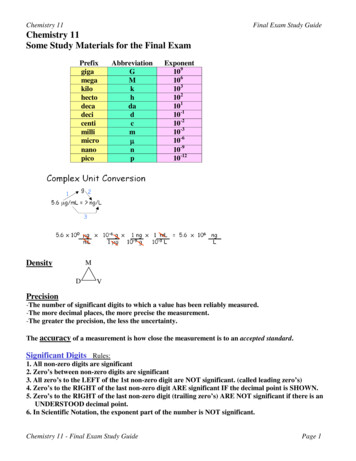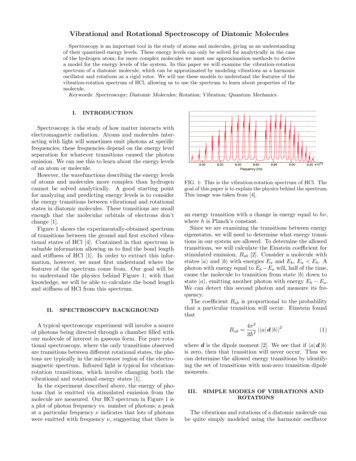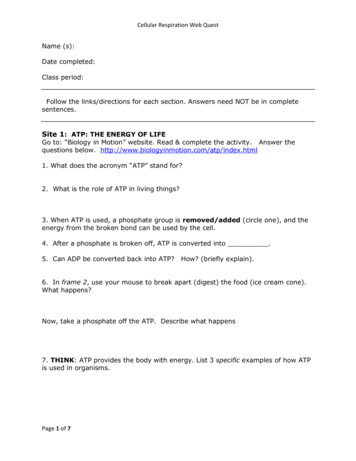
Transcription
MO Diagrams forDiatomic MoleculesChapter 5Friday, October 9, 2015
Homonuclear Diatomic MoleculesWhat happens when we move to more complicated systems?Consider O2. The Lewis dot structure famously predicts the wrong electronicstructure for O2 We can use LCAO-MO theory to get a better picture:Notice thatEσ Eπ,because theσ bonds havemore overlapthan π bondsEσ2pa2saEπ2pb2sb
Electron Configurations and Bond OrdersJust as with atoms, we can write amolecular electron configuration for O2σ2σ*2σ2π4π*2We can also calculate the O–O bond order:1BO # bonding e # anti-bonding e 21 8 4 22LCAO MO theory also predicts (correctly) that O2 has two unpairedelectrons.
Orbital MixingOrbitals of similar but unequal energies can interact if they have thesame symmetryThe 2s and 2pz orbitals form MOs with the same symmetry (σg and σu).sp mixing causes the σg and σu MOs to be pushed apart in energy:The σ andπ orbitalschange order!
Orbital MixingThe size ofthe effectdepends onthe 2s-2penergydifference.small Zeff small energydifference large sp mixingorder changeslarge Zeff large energydifference small sp mixing
MOs of Homonuclear Diatomic MoleculesThe MO picture of homonuclear diatomic molecules depends on theamount of sp mixing.Li2, Be2, B2, C2, N2O2, F2, Ne2
Bond Order and Bond DistanceThe MO bond order is the main factor controlling the internucelardistance.B2σ2σ*2π2BO 1F222σ σ* σ2π4π*4BO 1O2–σ2σ*2σ2π4π*3BO 1.5C22σ σ*2π4C22–σ2σ*2π4σ2BO 3BO 2O222σ σ* σ2π4π*2BO 2N2 σ2σ*2π4σ1BO 2.5N22σ σ*2π4σ2BO 3O2 σ2σ*2σ2π4π*1BO 2.5
Relative AO Energies for MO DiagramsPhotoelectron spectroscopy gives us a pretty good idea of the relativeenergies for AOs.LiHAlBNaCBeN–13.6 eVB1s2pCHeO–18.6 eVNe2sPMgAlFSiSiS3p3sPSNOF–40.2 eVNeClClArAr
MO Diagram for HFThe AO energies suggest that the 1s orbital of hydrogen interactsmostly with a 2p orbital of fluorine. The F 2s is nonbonding.σ*–13.6 eV1sEnergynbσ2p–18.6 eVSo H–F has one σ bondand three lone electronpairs on fluorine–40.2 eVHnb2sH–FF
Relative AO Energies for MO DiagramsPhotoelectron spectroscopy gives us a pretty good idea of the relativeenergies for AOs.AlBLiCBeHNa–10.7 eVNB1s–19.4 eVHe2pCO–15.8 eVNe2sAlS3p3sOFNeClPSN–32.4 eVPMgSiFSiClArAr
Heteronuclear Diatomic Molecules: COIn molecules with more than one type of atom, MOs are formed fromAOs that have different energies. Consider CO:σ*LUMO is on carbon too!Energyπ*HOMO is on carbon2paσ2pbπσ*Anti-bonding orbitalsget polarized towardscarbon2sa2sbσCC OOBonding orbitalsget polarizedtowards oxygen
SummaryMO Theory LCAO-MO Theory is a simple method for predicting theapproximate electronic structure of molecules. Atomic orbitals must have the proper symmetry and energy tointeract and form molecular orbitals. Photoelectron spectroscopy provides useful information on theenergies of atomic orbitals. Next we’ll see that symmetry will help us treat larger molecules inthe LCAO-MO theory framework.
So H-F has one σ bond and three lone electron pairs on fluorine. Relative AO Energies for MO Diagrams H He Li Be B C N O F Ne B C N O F Ne Na Mg Al Si P S Cl Ar Al Si P S Cl Ar 1s 2s 2p 3s 3p -19.4 eV -15.8 eV -32.4 eV -10.7 eV Photoelectron spectroscopy gives us a pretty good idea of the relative










